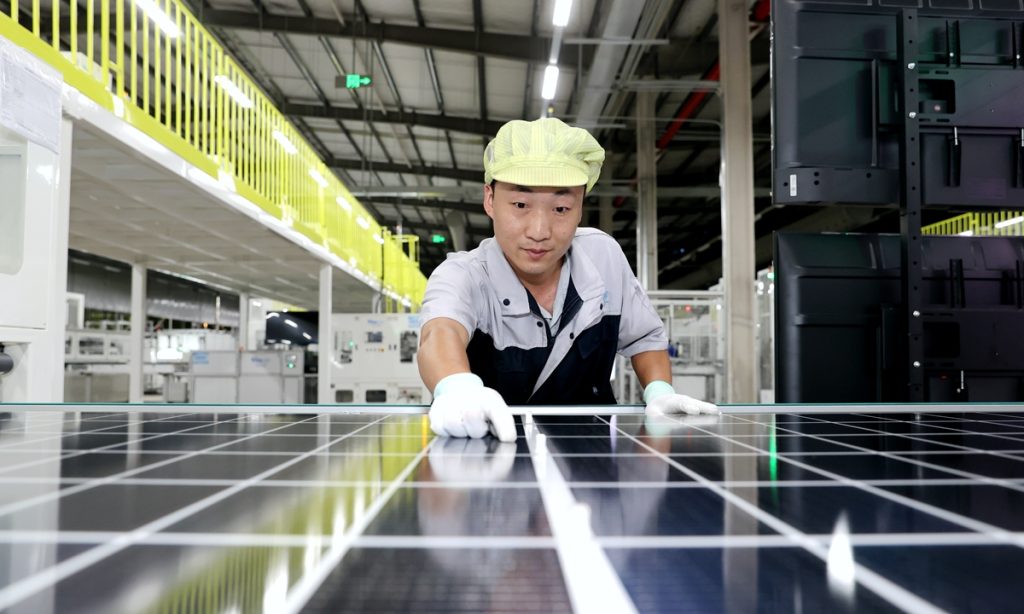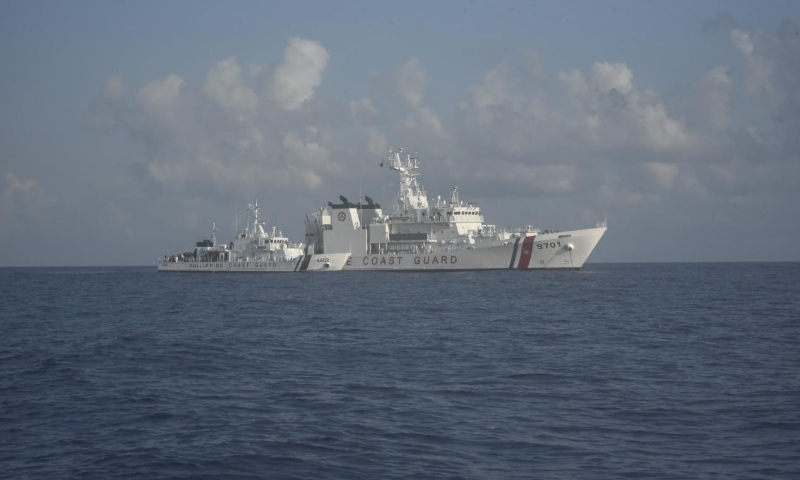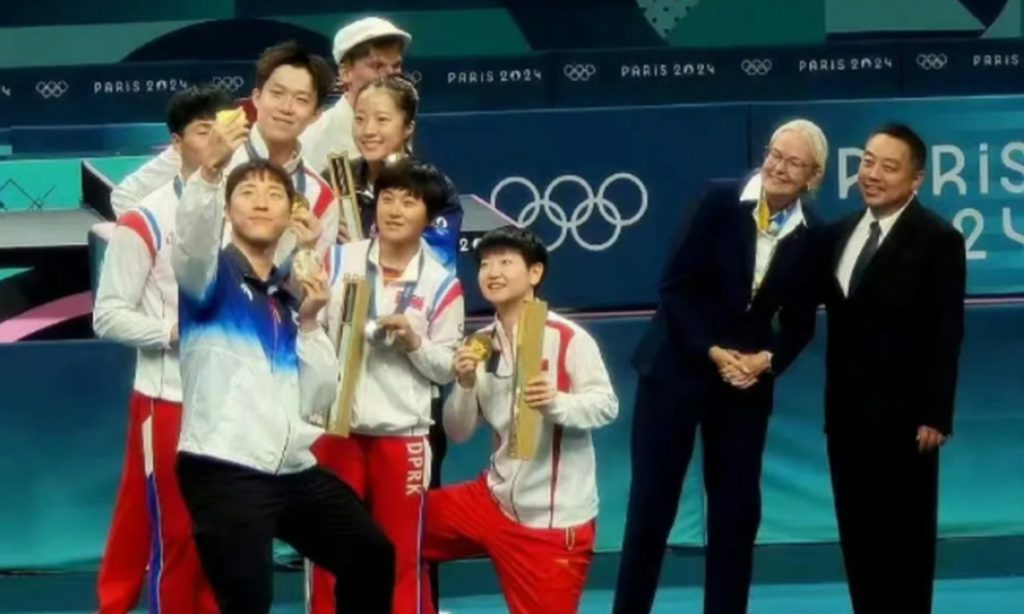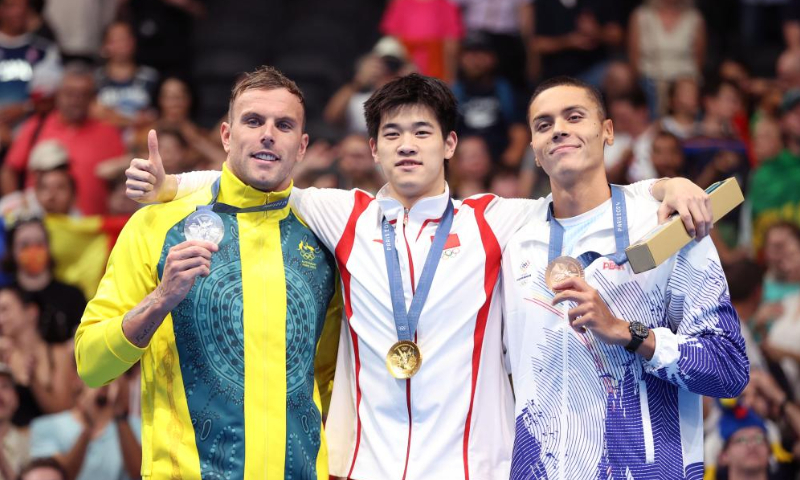Xi meets Spanish PM in Beijing
Chinese President Xi Jinping met with Spanish Prime Minister Pedro Sanchez in Beijing on Monday.
Chinese President Xi Jinping met with Spanish Prime Minister Pedro Sanchez in Beijing on Monday.

China unveiled the country's first standard outlining the functional, technical, and performance criteria for fake digital face detection services in the financial field at the 2024 Inclusion Conference on the Bund in Shanghai.
This standard, the first of its kind for artificial intelligence (AI)-powered face-swapping technology in financial services in the country, also incorporates corresponding testing and evaluation methods, according to the China News Services (CNS).
The standard specifies detailed requirements for functionality and performance, according to the report. At the functional level, relevant institutions should possess the capability to detect fake digital faces across different scenarios, including replacement, activation, and deepfakes.
In terms of performance, institutions should also establish a real digital face data set of no less than 5,000 images, along with fake face data sets of various forgery types to address complex real-life scenarios. Key factors include different skin tones, lighting conditions, levels of clarity, and whether or not voice is included.
This marks an important step in advancing AI safety, Qin An, deputy director of the expert committee on counter-terrorism and cyber security governance at the China Society of Police Law, told the Global Times on Sunday. He added that beyond this standard, defined qualification standards for certification bodies in AI technologies are also crucial to ensuring data security.
Recently, several chat rooms suspected of creating and distributing deepfake pornographic material using doctored photos of ordinary women were reportedly discovered on the messaging app Telegram, with many of the victims and perpetrators known to be teenagers, as reported by The Korea Times.
The incident gained attention in China following posts by netizens claiming to be South Korean women, expressing fears of the incident being overlooked in their country, according to thepaper.cn.

A recent trend of exquisite women dedicated to fully enjoy their experience on high-speed trains has gone viral, with related vlogs flooding Chinese social media platforms and sparking heated discussions.
During the journey, the blogger completes various tasks such as disinfection, humidification, and mite elimination. Additionally, they engage in activities like flower arrangement, brewing tea, and cooking instant noodles along the way. Unlike typical chaotic travel scenarios, the women in the videos used their carefully selected items to enhance both comfort and happiness during their train journeys.
Many netizens have shared their thoughts, noting that while the trips may be brief, the tasks undertaken are substantial, with many adding that they were impressed with the girls’ execution. However, there are individuals who have raised doubts regarding the necessity of emphasizing these intricate details during travel experiences.

As of August 26, State Grid Taizhou Power Supply Company has established 21 fully automated UAV nests in the main urban area of Taizhou, covering an area of nearly 400 square kilometers and achieving full coverage of intelligent UAV inspection for power transmission, transformation, and distribution equipment within the main urban area of Taizhou.
Currently, UAVs have become one of the effective means for inspecting power grid equipment. In the past, pilots would typically carry UAVs to the site for operations, but considering factors such as personnel and vehicle arrangements, equipment endurance, and job transfers, the effective working hours of each pilot group were only around 5 hours per day, making it difficult to fully meet the periodic inspection requirements of multiple disciplines.
Since this year, Taizhou Power Supply has leveraged the technical advantages of grid-based autonomous UAV inspection, optimized the location of nests and autonomous flight routes, and built a "radial" mobile UAV inspection network covering approximately 1,166 kilometers of transmission lines, 1,300 kilometers of distribution lines, and 24 substations.
Now, after initiating automatic inspection, UAVs can automatically execute tasks in the pre-set order without any human intervention throughout the flight operation. They can automatically manage the entire process from takeoff from the nest, operation, return, charging, and data transmission, significantly reducing labor costs.
According to Dai Yongdong, the head of the Intelligent Operation and Inspection Center at Taizhou Power Supply Company, after adopting the fully autonomous nest operation mode, the daily effective working hours of UAVs have reached 12 to 15 hours. Fine-grained inspections of transmission and distribution equipment can be increased from once every quarter to four times a month, and fine-grained inspections of substations can be increased from once every quarter to once every three days, significantly improving the quality and efficiency of equipment inspections.

The recent boom in the artificial intelligence (AI) industry has brought increased attention to the computing-related sector, including cloud computing and chips. With the rapid growth of AI applications in various industries, there is a growing demand for more powerful computing systems to support these applications.
Officials and industry leaders attending an ongoing industry expo have expressed confidence in the domestic development of advanced computing capabilities, as Chinese enterprises have made significant advances in the sector, relying on their experience and technology prowess.
The China International Big Data Industry Expo 2024, which opened on Wednesday in Guiyang, Southwest China's Guizhou Province, attracts many Chinese technology companies eager to capture a piece of the booming domestic AI-related industry.
Wang Chenghong, a representative of Henan Kunlun Information Technology Co, told the Global Times that the company has its own high-performance AI servers and self-developed technology for integrating AI with general computing.
In addition to establishing related infrastructure such as data centers, regions across China have rolled out measures to boost computing power infrastructure development.
Xu Lin, Party secretary of Guizhou Province, announced plans to further develop intelligent computing industrial clusters with a primary emphasis on AI technology.
The province aims to cultivate industry-specific large language models, enhance data center infrastructure and broaden the utilization of data elements across various sectors.
The computing power is reshaping global economic landscapes at an unprecedented pace, said Gao Wen, an academician at the Chinese Academy of Engineering, at a forum on Thursday.
To strengthen advanced computing capabilities and foster new quality productive forces, China has invested more than 43.5 billion yuan ($6.12 billion) in a nationwide project to build computing data centers, Liu Liehong, head of the National Data Administration, said at the expo.
China's massive investment in computing comes as it faces increasing restrictions from the US, which has limited exports of some advanced computing products, including those from industry leader Nvidia in recent years, according to Reuters.
As Washington steps up controls on chip exports to China, the US chipmaker is still actively seeking opportunities to collaborate with Chinese enterprises and benefit from their rapid progress.
While China was a "significant contributor" to the data center revenue in the past quarter, "it remains below levels seen prior to the imposition of export controls," Nvidia CFO Colette Kress said during an earnings call on Thursday. "We continue to expect the China market to be very competitive going forward."
China's success in self-reliant semiconductor production hinges on surmounting technological hurdles, navigating geopolitical complexities, and fostering a domestic AI chip supply that is both cutting-edge and economically viable, experts noted.

A local resident from Xuzhai Village in Dongyang, East China's Zhejiang Province, makes decorated lanterns for the Mid-Autumn Festival on September 3, 2024. Decorated lanterns from Xuzhai Village have a long history, integrating multiple techniques including wood carving, bamboo weaving and tailoring. They're sold in other parts of China as well as overseas markets. Photo: VCG

China's manufacturing sector showed signs of improvement in August, with the Caixin Manufacturing Purchasing Managers' Index (PMI) rising to 50.4, up 0.6 percentage points from July, bringing the index back above the expansion threshold.
The data suggest a pickup in demand, steady employment levels and improving business confidence, but challenges remain in the face of external uncertainties, according to the survey published on Monday.
A reading above 50 indicates an expansion in activity, while a number below signals a contraction.
The production index in August saw a slight increase in the expansion range, while the new orders index reversed its contraction in July and returned to expansion territory.
According to surveyed enterprises, growth in new orders was mainly driven by improvements in basic demand and various promotional measures.
Employment in the manufacturing sector stabilized in August, with the employment index hovering in expansion territory.
Manufacturers in the industry generally believe that factors such as business expansion, new product releases and an improvement in economic conditions will drive sales growth.
Wang Zhe, a senior economist at Caixin Insight Group, said that the August PMI data suggest a modest recovery in the manufacturing sector, with both supply and demand expanding, but challenges remain in achieving stable growth in the face of external uncertainties.
The Caixin data showed that external demand weakened in August, with the new export order index falling below the critical point for the first time this year, marking the lowest level since December 2023.
China's official manufacturing PMI released by the National Bureau of Statistics (NBS) came in at 49.1 in August, down from 49.4 in July.
Zhao Qinghe, an NBS statistician, attributed the slight drop to factors such as extreme weather and off-season production in some industries.
Zhou Maohua, an economist at China Everbright Bank, told the Global Times on Monday that there is a need for increased implementation of macroeconomic policies, with a continued focus on boosting effective demand and promoting domestic circulation.
The key priority is to accelerate the implementation of policies to fully unleash their benefits and boost market confidence. Additionally, policy support should be optimized based on the uneven recovery of different industries, Zhou added.

A US Navy patrol aircraft was reportedly spotted as a Philippine Coast Guard ship rammed into a China Coast Guard (CCG) vessel in the lagoon of China’s Xianbin Jiao in the South China Sea on Saturday, with experts saying the US plane serves as encouragement for the Philippines to conduct bolder and riskier provocations.
The Philippine Coast Guard ship MRRV-9701, which has been illegally stationed at China’s Xianbin Jiao, on Saturday lifted its anchor and conducted continuous maneuvers, stirring up troubles in the lagoon of Xianbin Jiao. CCG Vessel 5205 took measures including verbal warnings, monitoring and control in accordance with the law and regulations, Liu Dejun, a CCG spokesperson, said in a statement on Saturday.
In the process, the Philippine MRRV-9701 deliberately rammed into CCG Vessel 5205 in an unprofessional and dangerous manner, causing a collision for which the Philippines bears full responsibility, Liu said.
Liu demanded the Philippines to immediately withdraw its ship from the Chinese reef.
The CCG also released a video showing the Philippine ship sailing into the path of the Chinese vessel, causing the collusion.
The Philippines has repeatedly attempted to send supplies to the MRRV-9701 that has been illegally anchored in the lagoon of China’s Xianbin Jiao since April, first using ships then using a helicopter, marking serious violations to China’s territorial sovereignty and maritime rights and interests, as well as the Declaration on the Conduct of Parties in the South China Sea.
The latest movement by the MRRV-9701 showed that, unlike the Philippines’ old warship illegally grounded at China’s Ren’ai Jiao, the MRRV-9701 is capable of moving on its own, observers said.
Xue Chen, a research fellow at Shanghai Institutes for International Studies, told the Global Times that if the MRRV-9701 runs short of supplies, it should withdraw from Xianbin Jiao and return to the Philippines.
It exposed that the Philippine ship’s deployment at Xianbin Jiao is aimed at creating a false concept to smear China in the international community, with the aim of violating China’s sovereignty, Xue said.
During the incident, a US Navy P-8A maritime patrol aircraft was spotted on-site disrupting the CCG’s law enforcement operations, according to Yuyuan Tantian, a social media account affiliated with state broadcaster China Central Television.
A Beijing-based military expert who requested anonymity told the Global Times on Sunday that the US military aircraft could gather intelligence and potentially carry out jamming on Chinese vessels.
The P-8A’s presence serves as an encouragement to the Philippines to conduct harder provocations, the expert said, noting that US aircraft could also serve as an aerial military “journalist” contributing to its scheme of throwing mud on China.
Such moves will only sabotage peace and stability in the South China Sea, experts said, predicting new rounds of provocations by the Philippines in near future, backed by the US.

After the mixed doubles table tennis final match was held at the Paris Olympics on Tuesday, Chinese gold medalists Wang Chuqin and Sun Yingsha, North Korean silver medalists Ri Jong-sik and Kim Kum-yong, and South Korean bronze medalists Shin Yu-bin and Lim Jong-hoon, posed for a group selfie. This friendly interaction among these athletes has sparked widespread discussion.
When Kim, the North Korean female player, experienced a microphone issue at the post-match press conference, Wang took the initiative to check and gave a hand, showing a good sportsmanlike demeanor.
Despite being competitors on the field, athletes' ability to communicate and interact amicably on the podium demonstrates the deep friendship and mutual respect among them. The photograph of the three nations not only captures their moment of glory but also embodies the Olympic spirit's essential values of friendship and unity.
Sun expressed gratitude towards her partner Wang, stating that the Olympics is the most sacred and prestigious competition.
"Participating in an international competition and the Olympics for the first time, I feel both happy and a bit regretful," Kim said after the final match.
"We have learned a lot from competing against the world's top-ranked Chinese team. We will train harder and aim to win the gold medal next time... the Chinese team are the world's top team, we did our best" she said.
Regarding Wang as an idol, Shin said, "At the Chengdu mixed team event, I went to ask for Wang Chuqin's autograph and took a photo with him. He was very friendly."
"I've faced Wang in mixed doubles many times. His strength is impressive, and it's difficult to return his shots. Every time I have to return his ball, I feel that it's a real challenge, a feeling of 'as expected of the world number one.'"
These interactions and mutual respect between athletes transcend national and ethnic boundaries, highlighting the sincerity and inclusiveness present in competitive sports, experts said.

The "emotional entanglement" between Chinese swimmer Pan Zhanle and Australian swimmer Kyle Chalmers during the ongoing Paris Olympics, which began with a misunderstanding but ended in friendship, has captured the attention of Chinese netizens over the past few days.
The story started when Chalmers did not acknowledge Pan's greeting before the men's 100 meters freestyle swimming competition, which Pan interpreted as "deliberate."
In a subsequent media interview, after Pan broke his own world record to win gold in the men's 100 meters freestyle, he expressed disappointment that Chalmers did not respond to his attempt at friendliness. Pan also remarked that some foreign swimmers lacked respect for Chinese athletes and coaching staff.
Pan's comments quickly went viral on Chinese social media, leading many netizens to criticize Chalmers for his perceived bad manners and arrogance.
Chalmers later clarified that he had not seen Pan's greeting and reached out to him personally afterward. He also sent a private apology to Pan, who responded positively by exchanging swim caps with Chalmers.
Chalmers shared photos on social media of the exchanged swim caps, including Pan's, and their handshake. They also exchanged contact information, and Pan said he is looking forward to showing Chalmers around Shanghai, the first stop of the World Aquatics Swimming World Cup 2024 in October.